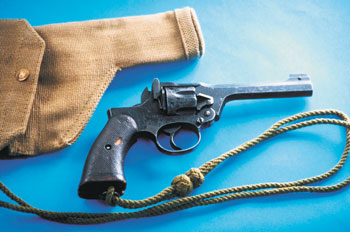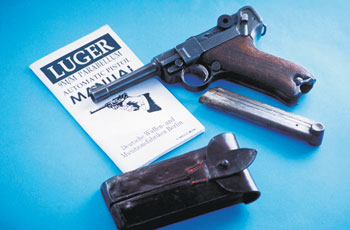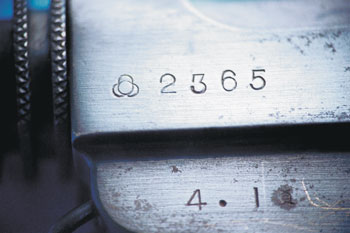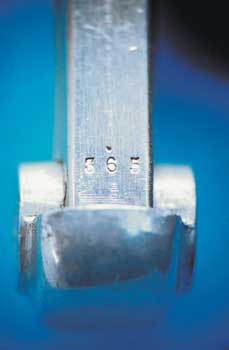Motives of a handgun collector
by Geoff Smith
Australian & New Zealand Handgun 1
 Collecting handguns has become a
serious hobby for many gun enthusiasts. This has seen prices escalate
during the past couple of decades, as older guns migrate from grandpa’s
toolbox to collector’s display case. Once relatively common military
Collecting handguns has become a
serious hobby for many gun enthusiasts. This has seen prices escalate
during the past couple of decades, as older guns migrate from grandpa’s
toolbox to collector’s display case. Once relatively common military
Many such guns have achieved ‘classic’ status and are thus highly sought after. High on the list, for example, are the Model 1896 Mauser (‘Broomhandle’) and its derivatives and the many possible variations of Imperial German P-08 (‘Luger’). Among dozens of others, collectors might seek various Astras, Berettas, Colts alphabetically through to S&Ws, Tokarevs and Webleys. This article explores what motivates handgun collectors and what benefits such collecting might offer society in general.
Collectors often follow a particular theme. Finding the required firearms has become increasingly difficult as demand rises and availability declines. If it were easy, most people would probably soon lose interest. Apart from market forces and the vagaries of supply and demand, availability sometimes also declines for more sinister reasons. The equation includes potential collectors, various dealers and vendors, the authorities tasked with the regulation of firearms ownership and most importantly, prevailing laws, community attitudes and public policy.
While the military theme is popular, there are many other possibilities, which, for example, might include chronological collections of particular manufacturers, countries or styles. Some collectors concentrate on Colts or Rugers. Others might specialise in designs copied from the self-loaders of JM Browning. One person may choose to collect Belgian purse pistols, while another might look for colonial weapons from Australia’s early days. Flintlock and percussion pistols command high prices and are very popular. Breech-loading pistols though remain much more widely available than the real old-timers. Some of the earlier breech-loaders may still not require registration where they are old enough and of an obsolete calibre. Pinfire and certain rimfire revolvers are examples. This factor influences many collectors who do not wish to bother with licences and such.
In his book Service Arms of the SA Police (Antique and Historical Arms Association of SA Inc, 1988) Max Slee tells the now heartbreaking tale of how the SA Police divested itself of its old weapons back in 1952. A consignment including 82 Adams .450 and 233 S&W .44 Russian revolvers, 293 Martini Henry .577-.450 rifles and 177 carbines of like calibre (plus a vast quantity of ammunition, bayonets, holsters, scabbards and other surrendered pistols) were virtually dumped onto the US market as a bulk lot for a total of just $2506. On today’s market (based on recent auction prices) this little lot would bring roughly $800,000 here in Australia and maybe twice this in the USA. But, hey, at least they didn’t get destroyed.
 In more
recent times an ignorant process of obsessively melting down
‘surrendered and seized weapons’ purely because they are guns has
destroyed rare and, in some cases, irreplaceable handguns. They haven’t
just disappeared locally. These guns have gone forever. The fact that
they could command astonishing prices overseas is ignored. The fact
that, particularly those firearms associated with criminal activity,
might be of great use to historians and scientists in the future is
also ignored. This mindless approach to ‘policy’ is no less than
applied ignorance. Sadly, in recent times it seems that wherever a
serious heritage issue arises, ignorance can always be found lurking
nearby to overwhelm logic.
In more
recent times an ignorant process of obsessively melting down
‘surrendered and seized weapons’ purely because they are guns has
destroyed rare and, in some cases, irreplaceable handguns. They haven’t
just disappeared locally. These guns have gone forever. The fact that
they could command astonishing prices overseas is ignored. The fact
that, particularly those firearms associated with criminal activity,
might be of great use to historians and scientists in the future is
also ignored. This mindless approach to ‘policy’ is no less than
applied ignorance. Sadly, in recent times it seems that wherever a
serious heritage issue arises, ignorance can always be found lurking
nearby to overwhelm logic.
Some dealers rationalise this mindless ‘destruction as a matter of policy’ by saying that such destruction reduces availability and thereby helps inflate the prices of the remainder. This attitude puts profit ahead of conservation. To most of us, price and value are two quite separate factors. Destruction of any firearms simply because they are potentially weapons is the wilful and wanton vandalism of weak, narrow-minded fools. So, what is the appeal? What burning passion impels collectors to accumulate, study, display, discuss and conserve handguns?
A collection of any kind obviously begins with one single item. Having somehow obtained this item, the owner commences a process of research. The process is often informal and sometimes even subconscious. The curiosity evoked by possession of this particular firearm may initially relate to the person from whom it was obtained rather more than from the gun itself.
Perhaps one inherits an old Luger that the late lamented Uncle Fred liberated from Villers Bretonneaux in 1919. Old Fred probably kept it, illegally after about 1930, yet wilfully and defiantly for the entire duration of his life. Perhaps he took somebody else’s life to obtain it in battle. Possibly he simply found it lying on the ground. Maybe he won it in a two-up game.
 Whatever the circumstances, Uncle Fred clearly valued it as a keepsake
because he kept it for so long. Perhaps for him it was tangible
evidence of another time, a dreadful, terrifying time probably, but one
that was also the greatest adventure of his life. From family
information, you might be privy to some of these personal details,
which add to its individual family heritage value. As the new, and
hopefully now legal owner, maybe you log onto the bibliographical
section of the Australian War Memorial in Canberra
(http://www.awm.gov.au/database/biographical.asp) and check out Uncle
Fred’s army records. You enter his name and the state from which he
enlisted and suddenly there is a brief summary of his service details.
Whatever the circumstances, Uncle Fred clearly valued it as a keepsake
because he kept it for so long. Perhaps for him it was tangible
evidence of another time, a dreadful, terrifying time probably, but one
that was also the greatest adventure of his life. From family
information, you might be privy to some of these personal details,
which add to its individual family heritage value. As the new, and
hopefully now legal owner, maybe you log onto the bibliographical
section of the Australian War Memorial in Canberra
(http://www.awm.gov.au/database/biographical.asp) and check out Uncle
Fred’s army records. You enter his name and the state from which he
enlisted and suddenly there is a brief summary of his service details.
From a few of these details (such as the unit in which he served and his service number), you find you can purchase a full transcript of his service record. Having established that he was with a particular unit, it is likely that a history of this unit, coupled with Uncle Fred’s service records, will enable a great deal of information to be gathered in relation to this pistol. The pistol has thus become a part of living history to you in particular, as the owner, but also to the whole nation in general.
So now you carefully dismantle Uncle Fred’s Luger and then get out the books. The marks on the gun will reveal when and where it was made. The serial number and proof markings will, with detailed study, tell the physical history of the gun. The military records might show also the range of enemy units from which it was possibly souvenired.
The process of determining the above information often leads the beginning collector to other people who own similar items. These days, to even be regarded as a firearms collector, one must belong to a collector club and meet the attendance requirements of so many meetings per year in order to justify the collector licence. But even if this were not the case, most collectors seek out other like-minded people if for no other reason than to compare notes about the items being sought. Often where a person has one item, interested fellow club members will say that they know where there is another such item or perhaps a related item that might be for sale.
 Assume, for example, that you acquire a Nambu pistol through a family
connection. You are intrigued by the peculiar markings, the crudely
executed wooden grips yet the remarkable rust blued finish and
nickel-plated magazine. At this point you know very little about the
weapons of Imperial Japan, but after making a few inquiries at the
club, it turns out that a fellow club member has a magazine and some
parts, somebody else has a holster and yet another person invites you
to come and inspect his collection of WWII Japanese militaria. He gives
you a brief run-down on General Kijiro Nambu, Japan’s most famous
small-arms designer.
Assume, for example, that you acquire a Nambu pistol through a family
connection. You are intrigued by the peculiar markings, the crudely
executed wooden grips yet the remarkable rust blued finish and
nickel-plated magazine. At this point you know very little about the
weapons of Imperial Japan, but after making a few inquiries at the
club, it turns out that a fellow club member has a magazine and some
parts, somebody else has a holster and yet another person invites you
to come and inspect his collection of WWII Japanese militaria. He gives
you a brief run-down on General Kijiro Nambu, Japan’s most famous
small-arms designer.
You take the pistol along to a meeting and discover that the numbers on the right-hand side of the receiver tell you the year and month in which it was made. That funny ‘Mickey Mouse head with three ears’ symbol, in fact, represents the top view of a pile of four cannon balls. It is the mark that, on this firearm, symbolises the Kokura Arsenal near Tokyo. It could just as easily have featured three circles depicting the ‘fighting fish’ symbol of the Nagoya Arsenal. A club member shows you how, on firing the last shot, the bolt locks open, not on a separate catch like many other military pistols, but on the actual magazine, which tells nearby enemy forces you are out of ammo because you need two hands to change magazines.
Not long afterwards you find an Arisaka rifle for sale at the local gunshop. It has similar arsenal markings to the pistol so you purchase this too. Now that you are hooked, you start to really become keen on anything to do with weapons and militaria of this period. From being the novice at the club who wanted to find out more about an inherited pistol, now, a few years down the track, you are the person who others come to see in order to find out how to identify those funny marks and numbers on such firearms. You have obtained books and photocopied articles relating to this area of conflict.
Perhaps you have established contact with fellow collectors in other states or overseas. Your collection could extend to other items of militaria, such as Japanese swords, flags, helmets, medals and such. Other collectors might focus more specifically on handguns but spread the interest out to obtain examples of other handguns from the same conflict. Jan Still’s book Axis Pistols (Jan C Still, Alaska, USA, 1986) gives details of literally dozens of different makes and models of handguns that were employed by the various armed forces of Germany, Japan and their allies during WWII.
So what is the value of this mildly obsessive behaviour? Does it sound to you, the reader, like the path being trodden by some kind of psychopath? Those of us who collect handguns (or other items that could loosely be described as ‘weapons’) view them in a variety of ways, but principally as a symbol of human nature. While many detractors would say it is a side of human nature that should be discouraged, it nevertheless exists.
All worthwhile human arts evoke controversy. If they did not, we would soon lose interest. The student of firearms is as much interested in shape, appearance, the combination of ideas and utility, as in history, technology and engineering. The study of guns is fascinating, rewarding and helps keep many aspects of history alive. Like all forms of recreation, it brings serious and tangible rewards to all of society. The hazards associated with having a properly stored gun collection are probably much less than owning and using power tools, let alone driving on today’s roads.
